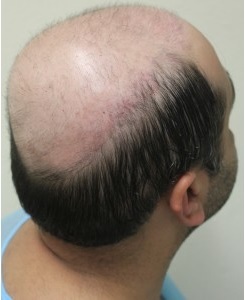Donor Hair Expansion with BHT
Conventional transplants use only hair from the head. This only allows for approximately 5,000 to 7,000 potential follicles available to transplant. Someone with severe hair loss who is bald can only transplant a portion of lost hair. This will result in inadequate coverage. UGraft BHT increases the donor supply using non-head hair harvested from other parts of the body and face. This includes other hair from the face such as the beard. It also allows for the chest, stomach, shoulders, arms and legs as potential sources. Patients who lack sufficient donor hair on the head are now able to achieve full coverage with transplantation.
Benefits of BHT
- Increased donor hair supply
- Expanded donor area
- Fast recovery time
- Minimal scarring
- Suitable for the severely bald
- May repair previous botched surgery
- Highly effective for eyebrow restoration
Hair loss from androgenetic alopecia, also known as pattern baldness, is the most common reason for severe baldness. However, baldness is the increasing result of past hair transplantation surgeries. Older techniques often produced extensive scarring and unnatural appearance. Scalp reduction and strip surgery procedures eventually result in stretching scars. When baldness reoccurs after initial surgery to restore hair loss, it is even more difficult for the patient.
Many times the donor supply on the head is nonexistent in second surgeries or not suitable for use in traditional transplants. BHT alleviates this issue by expanding the donor area to the body and allows the use of approximately 20,000-plus potential grafts. Even patients with severe scarring can now employ this hair transplantation with incredible results.
BHT Eyebrow Transplantation
Cautions for Candidates Wanting BHT
A majority of those with hair loss are good candidates for BHT despite levels of baldness or scarring. However, some people don’t have hair sufficient body hair and others have body hair that is nor suitable for transplant. Other candidates are not suitable based on health and other factors, including:
- Those with extremely curly and/or kinked hair, such of those of African descent (This hair type may affect transaction rate during the process of extraction.)
- Individuals affected by pattern baldness under 24-years-old (Hair loss is usually not complete, resulting in an uneven appearance and more surgery.)
- Those with allergies to anesthesia
- Those with a medical history of scarring or keloiding tendencies
- Those with a medical history of blood clotting abnormalities
BHT has many benefits in addition to traditional hair transplantation but there are additional risks. It is a more time-consuming procedure that requires greater skill of the surgeon. Non-head hair is more arduous to extract. It also more challenging to punch follicular units due to its varying degrees of angles. The procedure is also more laborious.
Body hair acts and looks differently than head hair. It remains the same in terms of growth and volume. Blending may be more difficult, and length will be compromised. However, an experienced surgeon understands the innate characteristics of body hair and makes placements accordingly.
Dr. Umar discusses the potential of BHT to alleviate hair loss issues in those who are bald in his article, “Hair Transplantation in Patients with Inadequate Head Donor Supply Using Non-Head Hair,” published in the October 2011 issue of the Annals of Plastic Surgery.

